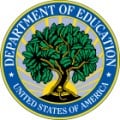Technology Trends In Education

This article will discuss four areas of emerging educational technology trends. These emerging trends are evident in the workplace and nationwide. Technology advancement has caused educational institutions to redefine how students learn. The No Child Left Behind Act has included technology standards into the curriculum. As result, school districts use distance learning and technology funding for training. The following will analyze emerging technology trends in online programs and technology standards, funding and training.
On-line Educational Programs
On-line educational programs are one of the emerging trends in educational technology. Because of the advancement of technology and the availability of the internet, educational institutions have redefined how students can learn; “academia has become highly dependent on the internet for administrative purposes as well as for teaching and research.” (Masood, n.d., p.1) According to a 2003 survey, “sixteen states reported offering Internet or computer based assessment.” (Bakia, Mitchell, & Yang, 2007, p. 3) Today, an internet search for schools offering on-line programs yields worldwide results. Students at all grade levels can participate in online programs.
Educators have found online programs to engage students in collaborative learning activities. The availability of online instruction and technology usage has prompted theories such as the constructivist to be “revisited.” (Bakia, Mitchell, & Yang, 2007, p. 2) The constructivist theory asserts that students “construct their own knowledge by selecting and transforming information, constructing and refining hypothesis, and design making.” (University of Florida, n.d, p. 1) The online format replaces traditional instruction and enables students to achieve.
10 Reasons To Integrate Technology
Do you think technology will continue to advance?
Technology Curriculum Standards
The integration of technology standards into the curriculum is the second emerging technology trend. Curriculum coordinators ensure that teachers understand technology integration. Teachers are able to design collaborative projects, which produce various types of learning outcomes such as, PowerPoint presentations, graphs, tables, web pages, and spread sheets. In the work place, students seem excited about learning when working in collaborative teams. “Discovery learning is one of the major themes of constructivist theory. One of the implications of the theory is the importance of learner motivation.” (University of Florida, n.d., p. 1)
One of the benefits of collaborative projects is the transferability to the real world. Administrators meet with businesses to discuss what practices are being used and how the curriculum can prepare students for future employment. One of the goals of the Enhancing Education through Technology (EETT) Program is “to assist every student in crossing the digital divide by ensuring that every student is technologically literate by the time the student finishes the eighth grade.” (Bakia, Mitchell, & Yang, 2007, p. 4)
Technology Funding
The advancement of technology has prompted educational institutions to search for technology funding, which is the third emerging trend. Funding for education is a challenge, because several programs need servicing. In 2004, the federal government contributed “7.8 billion.” (Bakia, Mitchell, & Yang, 2007, p. 12) A noticeable rise in funding occurred in “1998 through FY 2003.” (Bakia, Mitchell, & Yang, 2007, p. 12) However, the federal government has not maintained or increased funding “declines in FY 2005 and FY 2006.” (Bakia, Mitchell, & Yang, 2007, p. 12) Today, some school districts are struggling to keep up with technologies ever changing advancements.
In the work place, teachers should have at least two classroom computers with a printer. However, some grade levels complain that only one computer works, no printer, or computer equipment is too old, and no internet access. The local school counsel and Title 1 funds are relied upon to replace or update technology. In one school, Title 1 funds were used to purchase the web based program Study Island. This program is customized for ISAT standardized testing and enables teachers to track improvements. Study Island has proven to be an excellent tool to raise student reading and math test scores. Admittedly, adequate technology funding is crucial for keeping up with technology advancements. For example, Microsoft Windows XP has already been replaced with Windows Vista or Windows 8. These changes could eventually lead to database and technology implementation costs. Therefore, school administrators work tirelessly to find technology funding.

Technology Training
The last emerging trend in educational technology is training. It seems that yearly technology updates are made. This results in the need for consistent training of teachers and students. Today, teachers receive training incentives such as, credits towards re-certification. Workshops and professional development days enable teachers to receive technology training. In a personal workshop experience, teachers were taught how to create a PowerPoint presentation. This activity modeled how various technology resources can be used regardless of internet access. Some schools use the Star Schools program, which focuses on “partnerships to integrate audio and visual media.” (Bakia, Mitchell, & Yang, 2007, p. 12) Media specialist and teachers reinforce technology skills such as, saving, retrieving, designing, research searches, and using various technologies. Colleges and universities are training new perspective teachers in technology. Most new teachers have technology portfolios that are excellent guides for providing technology instruction.
In conclusion, technological advancements have initiated several emerging trends in technology. Access to the internet has paved the way for educational institutions to provide on-line programs. These online programs allow students to actively engage in collaborative activities. Curriculum coordinators ensure that technology standards are integrated into the curriculum. Students can create various types of technology products, which motivate learning. In addition, the need for funding is crucial for keeping up with technological changes. Lastly, teacher and student training are needed, which allows technology skills to be transferable to the real world.
References
Bakia, M., Mitchell, K., & Yang, E., (2007). State strategies and practices for educational Technology: Volume 1—examining the enhancing education through technology Program. Retrieved from website http://www.ed.gov/rschstat/eval/tech/netts/netts-vol1.pdf
Masood, M. (n.d.). A ten year analysis: Trends in traditional educational technology literature. Retrieved from website http://pppjj.usm.my/mojit/articles/pdf/1204 A%20Ten%20Year%20Analysis.pdf
University of Florida. (n.d.). Theories in educational technology. Retrieved from website http://www.coe.ufl.edu/school/edtech/theories.htm









